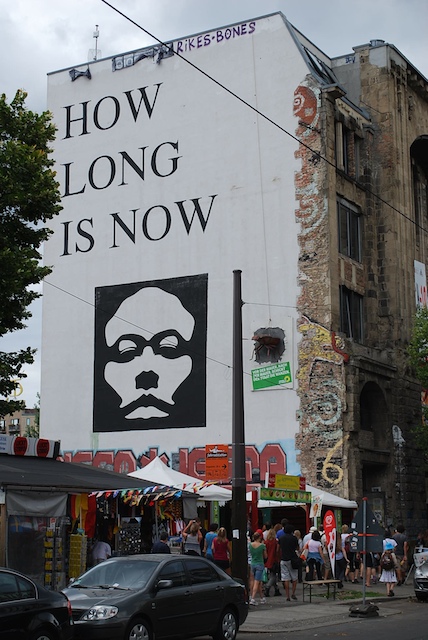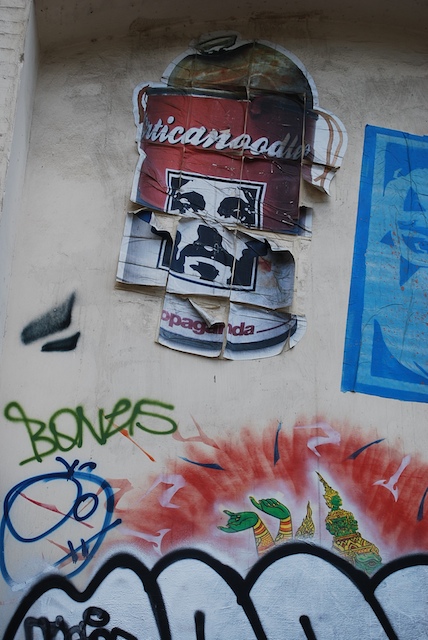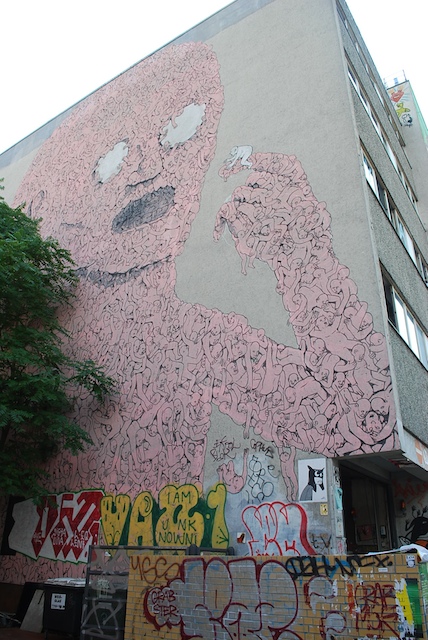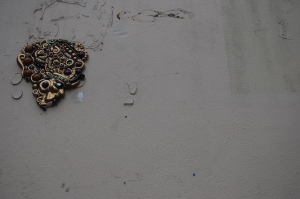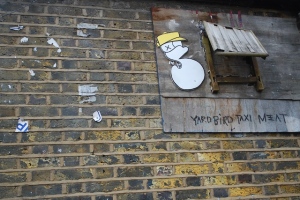Archive for the ‘Roa’ Tag
The Underbelly Project
As is by now well known to almost everybody with an interest in street art (and to quite a few more besides), a massive art project was organised by two individuals in New York City, and carried out with the involvement of more than 100 different artists from a range of countries – The Underbelly Project.
News of Underbelly recently broke in the New York Times and the London Times , and it’s fair to say that there has been quite the media furore about it.
(For many Australian readers, it may come as both a relief and a surprise to learn that ‘Underbelly’ refers to something other than an initially interesting and then subsequently tacky TV show on Channel 9….)
Underbelly, as an art project, is one of great audacity. It displays the work of the 100-plus artists on walls around a disused subway station in New York City. Painting had to be done in secret, during the night, and at some risk to the participants. It involved months of planning, organisation and execution, including documenting the artwork through photography and film. Artists whose work is displayed include Faile, Anthony Lister, Swoon, Indigo, Logan Hicks, Dan Witz, Rone, Meggs, PAC, Stormie Mills, Remi/Rough, Elbow-toe, Roa, Imminent Disaster, Mark Jenkins, Sheone, Smith/Sane, Revok and many more. You can see some of the works on Vandalog among other sites.
In April this year, I spent a few weeks in New York City, and met up with one of the two people behind Underbelly. I watched as he scrolled through dozens of astonishing photographs on his computer, explaining how lights had to be brought into the pitch blackness of the tunnel both for the artists to work and for the documentation of the process to be possible. Once the final piece had been painted, he told me, the entrance to the platform would be sealed off, and the location would be kept secret, so that the art would remain, and the documentation would attest to its existence, but no-one would be able to sell the images or to destroy it (time and the inhospitably humid environment of the tunnel would do that).
Hearing this account and seeing the images, I was quite awestruck. The project is so huge – partly because of the number of artists involved, with many coming from overseas, so even simply the logistics of coordinating visits to the tunnel, and allocating space within it was a major undertaking. It is also huge in that its execution took place over several months, in which the project, its nature and location must have been one of the best kept secrets in street art.
I was also captivated by the idea of taking street art underground, to a location that intersects with the history of graffiti and subway writing. I listened to the account of how the project would be independent of the art market, with the works existing within the tunnel, unable to be sold off afterwards (something that sounded extremely compelling, given that even works placed on the street for public enjoyment have often been removed in order to be sold).
And I must admit what got me the most was the idea that the tunnel would be sealed and no-one would be able to get in to see the artworks. It did give me a slight pang to think that such amazing works would be hidden from all spectators, but that was far outweighed for me by the romance of the idea that the artists would make the works, underground, in secret, in a space that acknowledges street art’s debt to the cultures of subway writing, and then that space, with all its beautiful artworks, would be sealed….
The very motivation behind Underbelly was a romantic one, I think. The project was born in the shared appreciation of two individuals for the empty and forgotten spaces of the city. It remained true to that shared sensibility; and it did not warp into something commercial.
It was one of the most exciting initiatives that I have come across, in all the years I’ve been thinking and researching in this area.
It felt incredibly exciting to see the media coverage of the project, and to see photographs of the works published so that they could be seen by others.
And my admiration for its creators knows no bounds.
But over the last several days, it would seem that, amongst the admiration and appreciation that has been offered, there are those who see Underbelly differently. Some seem to see it as a challenge, as if the organisers are saying, ‘go on, try and find it, bet you can’t…’ (see here for a forum in which some discuss how to find the tunnel and their experience of being arrested in doing so). Others seem to see it as a provocation, as though its existence needs to be condemned: this includes, interestingly, both the police, who are basically stationed at the location at present and arresting anyone who enters it, and individuals who have reportedly entered the tunnel and trashed some of the works. Still others have criticised the project’s creators, accusing them of cashing in,by making a documentary film about the project (this seems like such a bizarre criticism, given that the organisers felt that a film would allow a wider audience to get access to works that would otherwise be hidden from view. Full disclosure: I was interviewed about the project for the film.).
So: is there no romance left in street art? Maybe cynicism has taken hold of many of these commentators and critics, but in my opinion, the very existence of The Underbelly Project is a testament to the fact that some people in the world of street art (from the organisers through the artists who took part to the bloggers who visited the site and kept its secrets) still believe there is a place for hopeless romance amid the commercial imperatives of the market.
Berlin’s visitors….
As I mentioned before, I’ve recently been visiting Berlin. Like many cities with a reputation for interesting street art, Berlin attracts a wide range of artists who pass through the city for a short time and leave their work on the walls. So I thought I’d put up a selection of images by people who, like me, have been visitors to Berlin.
In the first few days that I was there, I went to see the Kunsthaus Tacheles, a massive building famed for its history as a squat and now as a centre for creative activity (although to me its atmosphere of hippie-chic cool seemed a little contrived and also somewhat dated…). On its external wall there’s a huge work by one of my favourite French artists, Yz (also known as Open Your Eyes) – and above it is the tag of one of Melbourne’s most prolific graffers, Bones (whose tag, along with those of other members of the 70K crew, I saw all over Berlin):
Here’s a small cat by C215, almost hidden in a corner to the rear of the building currently occupied by Kunstlerhaus Bethanien.
Bethanien is inextricably associated with Backjumps, the creative venture of Adrian Nabi, who over several years produced magazines and curated exhibitions and cultural events in Berlin, involving artists who work in public space. Over the years, artists such as Swoon, the London Police, Nomad, Brad Downey, Dave the Chimp and many other exhibited in Berlin under the Backjumps aegis. Part of the Backjumps events involved the curation of walls around the Kreuzberg area of Berlin for the display of works which would remain after the events were over. Here are a couple of examples, one from os gemeos and one from the London Police:
The area of Friedrichshain is also well known for its art on the streets, and the warren of bars, warehouses and skate park on Revaler Strasse contains hundreds of pieces, some commissioned, some added spontaneously. Amid a riot of tags, stencil, paste-ups and pieces near the Cassiopeia skate park I found a piece by Orticanoodles, with – once again – a tag by Bones accompanying it:
The River Spree constitutes a boundary between Friedrichshain and Kreuzberg, and as you travel over the Oberbaumbrucke (a wonderfully gothic looking bridge), the landscape is dominated by a massive piece by Blu, one of a number he has done in the city. Here’s a close up of the work:
Roa, the Belgian artist who has been achieving a lot of well-deserved attention recently, was in Berlin while I was there, and produced some fantastic work, such as this:
I also saw some old pieces in Kreuzberg by the French artist Nelio, whose work I admire greatly for its beautiful placement within any particular space (and which I’ve written about previously on this blog, see here). Here’s one:
And on my last night in Berlin, as I walked down Danen Strasse in Prenzlauer Berg to go back to my apartment, I discovered that Nelio must have been visiting Berlin once again, since a new piece had appeared:
It was nice to think that the phenomenon of artists making visits to this amazing city and contributing to the flux of images in public space was continuing, even as I was about to leave….
The textures of London
I spent a week in London recently. It’s always interesting to go back to a city after an absence of 18 months and see what’s changed. Usually it’s a matter of noticing which artworks have gone and which new ones are taking their place, but on this occasion I was struck by how much the area of Shoreditch itself had changed. Yes, there was still a lot of interesting art to see scattered through the streets, but whereas in July 2008 there were artworks around every corner, in May 2010 it would seem that the gentrification of Shoreditch has proceeded to the extent where entire streets have been so buffed that there is sometimes not even a sticker to be seen.
Fortunately there’s still a lot of work in areas such as Brick Lane, Hackney, and Bethnal Green, but you have to wonder what’s going to happen over the next 18 month as the Olympics approach. I’m guessing that there will be a huge buffing effort, and this, along with the increased surveillance (in the city that already has more cameras than any other I can think of) will inevitably have a chilling effect on the street art scene in East London. Hopefully it will simply move somewhere else in the city; it would be sad to see London lose the sense of productive possibility for street art that seems so characteristic of it.*
I don’t want to give the impression that things had already become bland – far from it. One of the striking things about this visit was seeing how lots of artists are producing works in which texture is a significant part of the visual experience: objects attached to walls, clever use of shapes and calls, a range of media, and extension of technique with paint. I know this is hardly big news, and I’m not meaning to pretend there has been any sudden shift in contemporary street art so that it’s suddenly all about texture or anything. Maybe it’s simply something that I was alert to, during this visit. Certainly some of the artworks I photographed are not necessarily ‘new’; some, in fact, have been up for a long time. But the overall effect for me was to bring out, in a very active way, the feeling of the city as existing in its textures and sensations – the material ‘things’ which make up everyday, urban life.
I’ve included a selection – see what you think.
Something simple to start with – simple, but I liked these cardboard hearts very much:
And someone is making mushroom sculptures, and placing them in high up, inaccessible spots, where they look down upon the passers-by:
More sculpture: I saw many of these amazing objects, each one different, attached high on walls, often near street corners. Great colours and shapes. Here’s a couple:
And here is one of my favourite street corners in London, and at the moment it contains a great selection of work, all placed high up, so that even the enthusiastic council cleaning crews can’t be bothered to remove them. This piece by Asbestos has been there for a couple of years now, and you can see another of the sculptures I just mentioned. There is also a little row of figures, now broken down to their torsos. You can find these on various London walls – I would love to know whose work this is.
I’m told this chair has been attached to the wall in Brick Lane for a long, long time, but now it has a satisfyingly chunky duck beside it for company:
On Rivington Street, opposite the entrance to Cargo and Black Rat Projects, there is a wall that has previously featured many paste-ups, stickers and so on. It’s pretty buffed at present, but it does have these two excellent additions.
One is a blue plaque, which reads: ‘This plaque was installed 6th May 2010’. The plaque mimics the historical marker plaques that provide information like ‘In 1856, so-and-so lived here for 2 months’, but it does so with a twist: the plaque commemorates the fact of its installation, rather than any particular event. Although it’s possible to read the plaque as having something to do with the election, the artwork is not about that as such (and it’s pleasing that the 6th of May was the day of the British general election which has subsequently acquired historical significance as the first election in Britain to result in a coalition government, but this certainly wasn’t known when the plaque was installed).
Next to the plaque, you can see a picture frame. Take a closer look:
Apparent detritus becomes art, in a work which is all about showcasing the feel and texture of things that would normally be overlooked and thrown away.
Finally, one of my main memories of visiting London this time is seeing Roa’s work in the streets. Roa is a Belgian artist whose show at Pure Evil gallery (and subsequently at Factory Fresh in Brooklyn) was a huge success, but in addition to those gallery shows he has also spent a lot of time putting work on the streets. He paints animals, usually oversized, and what’s so striking about these images is how Roa harnesses colour and spraycan technique to give an amazing sense of the texture of feathers or fur. Here’s my favourite of the ones that I saw:
And take a close look at the precision and delicacy of these ‘brushstrokes’: wonderful work.
*Thanks to Mark, from Hooked blog, for walking around Brick Lane with me….
 Comments (3)
Comments (3)